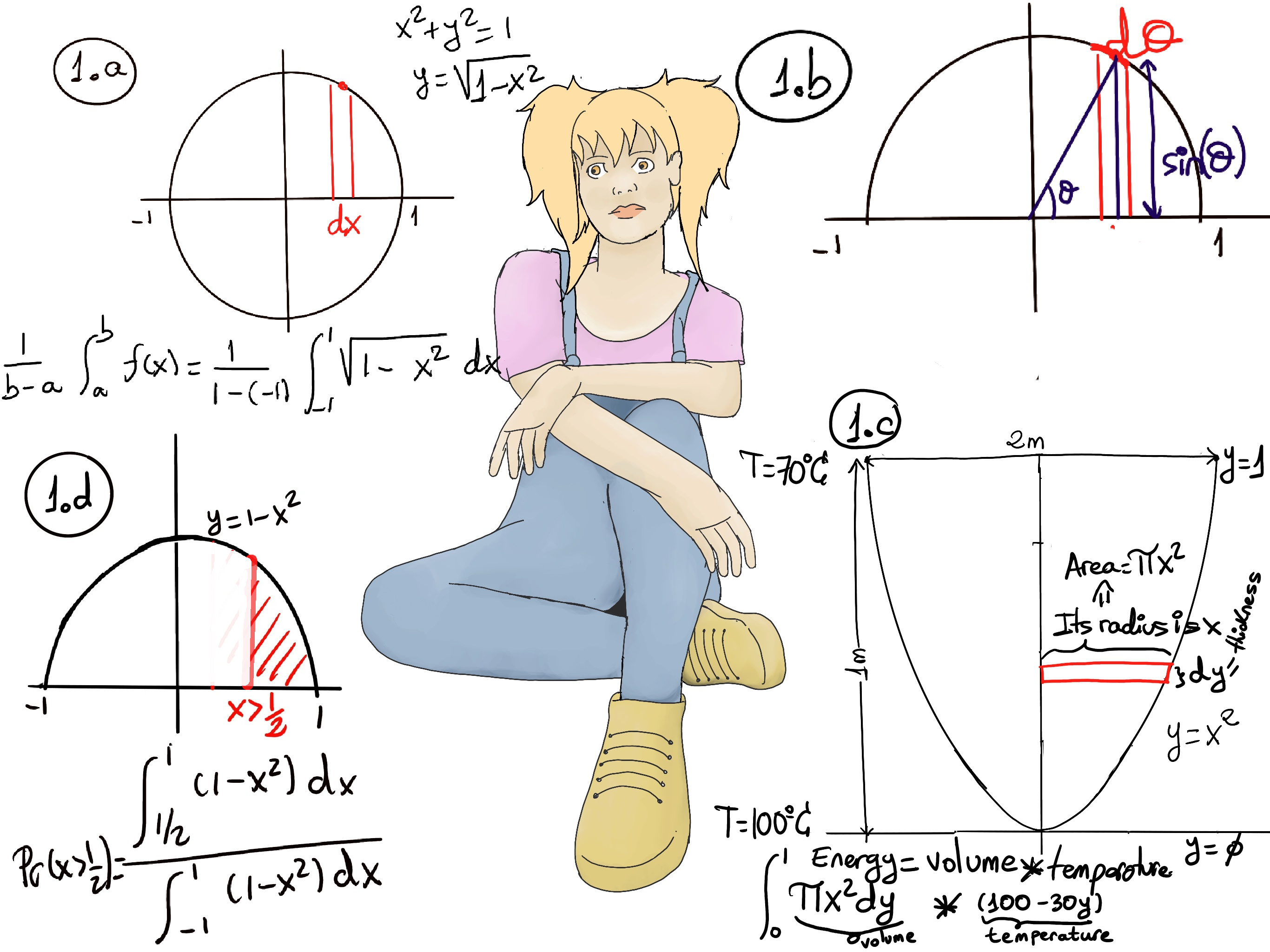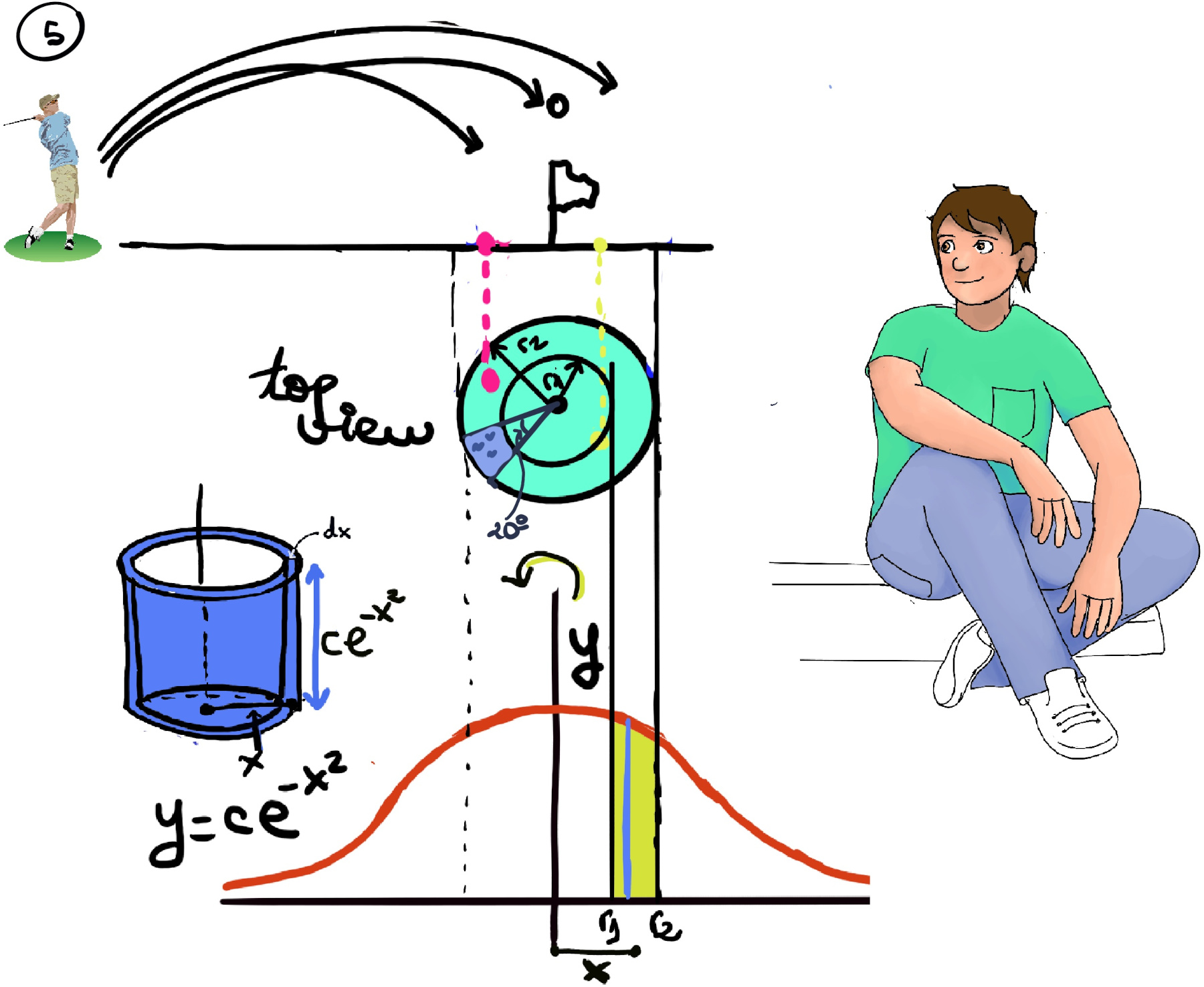
|
 |
 |

|
 |
 |
Oddly enough most people think they are better than average.
Antiderivatives are fundamental concepts in calculus. They are the inverse operation of derivatives.
Given a function f(x), an antiderivative, also known as indefinite integral, F, is the function that can be differentiated to obtain the original function, that is, F’ = f, e.g., 3x2 -1 is the antiderivative of x3 -x +7 because $\frac{d}{dx} (x^3-x+7) = 3x^2 -1$. Symbolically, we write F(x) = $\int f(x)dx$.
The process of finding antiderivatives is called integration.
The Fundamental Theorem of Calculus states roughly that the integral of a function f over an interval is equal to the change of any antiderivate F (F'(x) = f(x)) between the ends of the interval, i.e., $\int_{a}^{b} f(x)dx = F(b)-F(a)=F(x) \bigg|_{a}^{b}$
Definition. The average value of a continuous function f(x) over the interval [a, b] is AVG = $\frac{y_1+y_2+···+y_n}{n}$ where y1, y2, ···, yn represent the function values at specific points within the interval [a, b] and n is the total number of points where the function is evaluated within the interval [a, b].
Since integrals are essentially a sum of all of the possible f(x) values, AVG = $\frac{1}{b-a}\int_{a}^{b} f(x)dx$.
Said in a more mathematical way, $\lim_{n \to ∞}\frac{y_1+y_2+···+y_n}{n}$ = $\frac{1}{b-a}\int_{a}^{b} f(x)dx$ where $\int_{a}^{b} f(x)dx$ represents the signed area under the curve of f(x) between x = a and x = b, and $\frac{1}{b-a}$ is a scaling factor.
The weighted average of a list of elements x1, ···, xn with corresponding weights w1, ···, wn is $\frac{w_1x_1+w_2x_2 + ··· + w_nx_n}{w_1 + ··· + w_n}$. Note that if the weights are all just 1, that is, all elements or data points have the same importance, then the weighted average is just a plain average.
The continuous analogue of a weighted average can be obtained as an integral. Let f be a function defined on an interval [a, b], with weight w(x), a non-negative function on [a, b]. Then, the formula for calculating a weighted average of f on the interval [a, b] is $\frac{\int_{a}^{b} f(x)w(x)dx}{\int_{a}^{b} w(x)dx}$, e.g., f(x) = c ⇒ $\frac{\int_{a}^{b} f(x)w(x)dx}{\int_{a}^{b} w(x)dx} = \frac{c\int_{a}^{b} w(x)dx}{\int_{a}^{b} w(x)dx} = c$.

Average = $\frac{\int_{a}^{b} f(x)w(x)dx}{\int_{a}^{b} w(x)dx} = \frac{\int_{5}^{15} 2πxhw(x)dx}{\int_{5}^{15} 2πxhdx} = \frac{\int_{5}^{15} 2πxhw(x)dx}{\int_{5}^{15} 2πxhdx}$
The equation of the line passing through two points (x1, y1) and (x2, y2) is $y -y_1 = \frac{y_2-y_1}{x_2-x_1}(x-x_1)$ ⇒ The line that crosses between (5, 90) and (15, 23) is $T-90=\frac{23-90}{15-5}(x-5) ↭ T -90 = \frac{-67}{10}(x-5)↭ 10T -900 = -67x+335 ⇒ T = \frac{1235}{10}-\frac{67}{10}x$
Average = $\frac{\int_{5}^{15} 2πxhdxw(x)dx}{\int_{5}^{15} 2πxhdx} = \frac{2πh\int_{5}^{15} x(\frac{1235}{10}-\frac{67}{10}x)dx}{2πh\int_{5}^{15} xdx} = \frac{\int_{5}^{15} x(\frac{1235}{10}-\frac{67}{10}x)dx}{\int_{5}^{15} xdx} = \frac{\int_{5}^{15} (\frac{1235}{10}x-\frac{67}{10}x^2)dx}{\int_{5}^{15} xdx} = \frac{\frac{1235}{20}x^2-\frac{67}{30}x^3dx}{\frac{x^2}{2}dx}\bigg|_{5}^{15} = \frac{(13893.75-7537.5)-(1543.75-279.17)}{112.5-12.5} = \frac{6356.25−1264.58}{100} = \frac{5091.67}{100} = 50.91°C$
$Probability(x > 1/2)$ =[PART/WHOLE] $\frac{\int_{\frac{1}{2}}^{1} (1-x^2)dx}{\int_{-1}^{1} (1-x^2)dx}$ where w(x) = 1 -x2 -Figure 1.d.-. $\int_{\frac{1}{2}}^{1} (1-x^2)dx = (x-\frac{x^3}{3})\bigg|_{\frac{1}{2}}^{1} = (1-\frac{1}{3})-(\frac{1}{2}-\frac{1}{24}) = \frac{2}{3} -(\frac{12}{24}-\frac{1}{24})= \frac{16}{24}-\frac{11}{24} = \frac{5}{24}$.

$\int_{-1}^{1} (1-x^2)dx = (x-\frac{x^3}{3})\bigg|_{-1}^{1} = (1-\frac{1}{3})-(-1+\frac{1}{3}) = \frac{2}{3}-\frac{-2}{3} = \frac{4}{3}$.
$Probability(x > 1/2)$ =$\frac{\int_{\frac{1}{2}}^{1} (1-x^2)dx}{\int_{-1}^{1} (1-x^2)dx} = \frac{5}{24}:\frac{4}{3} = \frac{15}{96} = \frac{5}{32}$.
In general, a ≤ x1 < x2 ≤ b, P(x1 < x < x2) = $\frac{\int_{x_1}^{x_2} w(x)dx}{\int_{a}^{b} w(x)dx}$
Besides, p($\frac{-1}{2}≤x≤\frac{-1}{4}$) = $\frac{\int_{\frac{-1}{2}}^{\frac{-1}{4}} (1-x^2)dx}{\int_{-1}^{1}(1-x^2)dx}$ =[By symmetry] $\frac{\int_{\frac{1}{4}}^{\frac{1}{2}} (1-x^2)dx}{\int_{-1}^{1}(1-x^2)dx}$
$\int_{\frac{1}{4}}^{\frac{1}{2}} (1-x^2)dx = x-\frac{x^3}{3}\bigg|_{\frac{1}{4}}^{\frac{1}{2}} = \frac{1}{2}-\frac{1}{8}:3-(\frac{1}{4}-\frac{1}{64}:3) = \frac{12}{24}-\frac{1}{24}-(\frac{48}{192}-\frac{1}{192}) = \frac{11}{24}-\frac{47}{192} = \frac{88}{192}-\frac{47}{192} = \frac{41}{192}$
$\int_{-1}^{1} (1-x^2)dx = x-\frac{x^3}{3}\bigg|_{-1}^{1} = \frac{4}{3}$
p($\frac{-1}{2}≤x≤\frac{-1}{2}$) = $\frac{41}{192}:\frac{4}{3} = \frac{123}{768} = \frac{41}{256} ≈0.16$

First, let’s assume something about the golfer aim, #Number of hits = ce-x² where c is a constant representing the peak of the bell-shaped curve and x is the radial distance from the center of the flag stick to the golfer. It states that the locations where the golfer hits are normally distributed and follow a bell shape curve around the center of the flag stick.
p(r1 < x < r2) = $\frac{part}{whole}$
To calculate the part consider that we are integrating over cylinders of radius x, heights ce-x², and volumes 2πx·dx·ce-x² and we integrate from r1 to r2.
p(r1 < x < r2) = $\frac{part}{whole} = \frac{\int_{r_1}^{r_2} 2πx·ce^{-x^2}dx}{\int_{0}^{∞} 2πx·ce^{-x^2}dx}= \frac{πc\int_{r_1}^{r_2} 2xe^{-x^2}dx}{πc\int_{0}^{∞} 2xe^{-x^2}dx}$.
$part = πc(-e^{-x^2})\bigg|_{r_1}^{r_2}= πc(-e^{-r_2^2}-(-e^{-r_1^2})) = πc(e^{-r_1^2}-e^{-r_2^2})$
$whole = πc(-e^{-x^2})\bigg|_{0}^{∞}= πc(-e^{-∞^2}-(-e^{0^2})) = πc(0+1)= πc$
p(r1 < x < r2) = $\frac{part}{whole} =\frac{πc(e^{-r_1^2}-e^{-r_2^2})}{πc} = e^{-r_1^2}-e^{-r_2^2}.$
Notice that $\frac{d}{dx}(-e^{-x^2}) = -e^{-x^2}·(-2x)=2xe^{-x^2}$
 p(the_ball_lands_in_the_pond) = $\frac{part}{whole}$
p(the_ball_lands_in_the_pond) = $\frac{part}{whole}$part = $\frac{\int_{r_1}^{r_2} 2πx·ce^{-x^2}dx}{360}*20 = \frac{20}{360}πc(e^{-r_1^2}-e^{-r_2^2}) = \frac{1}{18}πc(e^{-r_1^2}-e^{-r_2^2})$
p(the_ball_lands_in_the_pond) = $\frac{part}{whole} = \frac{\frac{1}{18}πc(e^{-r_1^2}-e^{-r_2^2})}{πc} = \frac{1}{18}(e^{-r_1^2}-e^{-r_2^2})$
First, let’s assume something about the youngster aim completely analogous to the previous exercise. #Number of hits = ce-r². It states that the locations our youngster hits are normally distributed and follow a bell shape curve about the center of the dart board. He’s more likely to hit the dart board, but there’s some chance he’ll hit the wall next to it, or even worse his little brother.
As a general rule of thumb, we need to compute the probability of something by finding the ratio of the part to the whole. In our particular example, the “part” will be where the brother is and the “whole” is all the possible places, no matter how improbable, the dart could hit.
Let us consider a ring of the dart board. The inside of the ring will have radius r1 and the outside will have radius r2. If we plot y = e-r², we get a “side view” of our probability distribution where the heigh indicate that the darts are most likely to land near the center of the dartboard and less likely to land far out from the center -Figure 1.a-.

To calculate the probability of a dart landing in the ring, we observe the area between r1 and r2 below y = e-r² and above the r-axis, and compute the volume of revolution of this area revolving about the center of the dart board (y-axis). Taking into consideration that the probability of a hit is constant at any given radio, the probability of hitting inside the ring is $\int_{r_1}^{r_2} (2πr)e^{-r^{2}}dr = -πe^{-r^{2}}\bigg|_{r_1}^{r_2} = -πe^{-r_2^{2}}-(-πe^{-r_1^{2}}) = π(e^{-r_1^{2}}-e^{-r_2^{2}}).$
Recall that the probability function was $ce^{-r^{2}}$, but this fact does not really change our calculations much, so “part” = $cπ(e^{-r_1^{2}}-e^{-r_2^{2}}).$ “whole”, $\int_{0}^{∞} (2πr)e^{-r^{2}}dr = π(e^{0^{2}}-e^{-∞^{2}}) = π(1-0)$. Therefore, whole = cπ ⇒ P(r1 < r < r2) = $\frac{cπ(e^{-r_1^{2}}-e^{-r_2^{2}})}{cπ} = e^{-r_1^{2}}-e^{-r_2^{2}}.$
Let’s also assume that the probability of the youngster hitting the target is about 1/2, P(0 ≤ r ≤ a) = 1/2 ↭ P(0 ≤ r ≤ a) = 1/2 ↭ $e^{-0^{2}}-e^{-a^{2}} = \frac{1}{2} ↭ 1 -e^{-a^{2}} = \frac{1}{2} ↭ e^{-a^{2}} = \frac{1}{2}$ 🚀.
To figure out the probability of hitting the little brother, we are going to assume that he’s standing a distance of twice the radio (2a) away from the dart board, and approximate his location by an arc of a ring between 3 o’clock and 5 o’clock to the right of the board, that is 2/12 = 1/6 of a circle.
Therefore, the probability of the little brother getting hit is about 1⁄6P(2a ≤ r ≤ 3a) = $\frac{1}{6}(e^{-(2a)^{2}}-e^{-(3a)^{2}})$ =[(2a)2 = 4a2] = $\frac{1}{6}((e^{-a^{2}})^{4}-(e^{-a^{2}})^{9})$ = [🚀] = $\frac{1}{6}((\frac{1}{2})^4-(\frac{1}{2})^9) ≈ \frac{1}{6}\frac{1}{16} ≈ \frac{1}{100}$ or 1%.